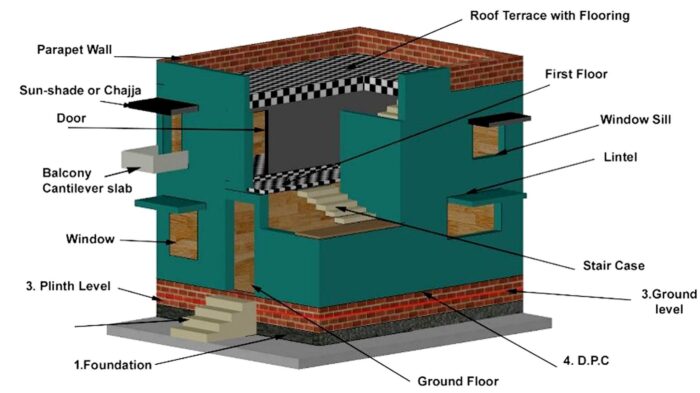1. What is the minimum no’s of bar for a rectangular column?
A rectangular column needs a minimum of 4 (four) rebar’s.
Two of which must be positioned vertically and two of which must be positioned horizontally.
The minimal quantity of reinforcing bars (rebar) needed for a rectangular column is determined by a variety of elements, such as the size and shape of the column, the weight it will support, the kind of construction material it will support, and local building codes.
 2. What is the minimum no’s of bas for a Circular Column?
2. What is the minimum no’s of bas for a Circular Column?
A circular column needs a minimum of 6 (Six) rebar’s.
With three bars evenly spaced apart and positioned at equal intervals all the way around the column.
To ensure proper reinforcement, the rebar is often arranged in a spiral design and connected together at the top and bottom of the column.
The minimal quantity of reinforcing bars (rebar) needed for a circular column is determined by a variety of elements, such as the size and shape of the column, the weight it will support, the kind of construction material it will support, and local building codes.
3. What is the minimum Thickness of Slab?
The minimum thickness for a residential floor slab is 5 inches (125 mm).
The minimum thickness for industrial or commercial slabs can range from 6 to 8 inches (150 to 200 mm)
 4. What is the Height of Single Story Building?
4. What is the Height of Single Story Building?
The height of a single story building is 3.15 meter / 10.50 feet.
Building codes and regulations, which differ depending on the area and the use of the building, set the precise height.
Some structures may have many levels within a single story, higher or lower ceilings, or both.
Consequently, there are various ways to define a “one story building.”
5. What is the Height for Window Level to residential buildings?
For egress and accessibility concerns, a window sill level bottom should typically be at least 900mm or 3ft above the ground.
Top of Window Level is below the Lintel which is 2.1 m or 7 ft.
Building codes and regulations, which vary by jurisdiction, typically dictate the height for window level in residential buildings.
In the event of a fire, this provides a clear entry for emergency escape or rescue. The bottom of a window sill can normally rise between 44 and 48 inches above the ground.
6. What is the Height for Sill Level for Residential buildings?
The level or distance from the floor to the bottom of the window frame is called as Sill level. It is generally kept about 900 mm or 3 ft.
Depending on local construction laws and restrictions, the height of a sill level for residential buildings can change.
The height of the window’s bottom compared to the room’s floor is generally referred to as the sill level height.
7. What is the Height for lintel Level for Residential Buildings?
Lintel levels normally range in height from 2 to 2.5 meters, but this might change based on the size of door and window openings as well as the room’s overall height.
The design and construction of the building, as well as regional building laws and regulations, all affect the height of the lintel level in residential structures.
8. What is the Minimum Height for Parapet Wall?
The International Building Code (IBC) stipulates that a parapet wall must be at least 30 inches (76 cm/760 mm) above the surface of the roof.
However, particularly in locations with significant wind speeds, some local construction rules may call for a higher minimum height.
Building codes, which vary by area, define the minimum height for a parapet wall. Generally speaking, a parapet wall needs to be high enough to offer adequate fire protection and shield people from falling from the roof.
9. What is the Weight of one Bag of Cement?
Standard weight of cement Bag is 50 Kg, Also some 25 Kg and 10 Kg bags are also available in the market.
The manufacturer, cement type, and location can all affect the weight of a bag of cement. It is crucial to remember that the weight of a bag of cement is not a consistent measurement, thus it is best to confirm the precise weight of the bags you are using with the manufacturer or supplier.

10. What is the initial Setting time of Cement?
According to ASTM C191, the standard test method for the time it takes hydraulic cement to set up using a Vicat needle, the first setting time of cement is typically between 30 and 45 minutes.
However, depending on the type of cement used, the ratios of the mixture, and the surrounding temperature and humidity, the actual initial setting time may differ.
The period of time between adding water to a dry mix and the point at which the mixture starts to stiffen and lose its flexibility is known as the initial setting time of cement.
11. What is the size of concrete testing cube?
Concrete testing cubes are typically cast in standard size of 150 mm x 150 mm x 150mm, also 150 mm x 100 mm x 150mm Sizes of cubes also used for concrete testing
The size of the concrete testing cube is important because it affects the accuracy of the test results.
Larger cubes are typically used to test higher strength concrete, while smaller cubes are used to test lower strength concrete

12. How many layer needs to fill for a Slump for Slump cone test?
Typically, 3-5 (three to five) equal layers of concrete are poured into the slump cone, and each layer is crushed using a tamping rod.
To prevent air bubbles or voids from affecting the reliability of the test findings, the concrete is uniformly tamped.
The workability of the concrete mix will determine how many layers are necessary.
In order to guarantee that the concrete is tightly compacted and free of voids, it may be possible to fill the cone in fewer stages with a highly workable concrete mix whereas more layers may be necessary with a less workable mix.
 13. What are the test to be done on Fresh Concrete?
13. What are the test to be done on Fresh Concrete?
Following tests can be done in fresh Concrete
1. Slump Test – For Workability
2. Workability Test
3. Compacting Factor test
4. Setting time test
5. Air Content Test
14. What is the minimum Curing period for Concrete?
Curing duration should not be less than 7-10 days for concrete exposed to dry and hot conditions and 14 days for concrete with mineral admixture.
15. What is the Water Absorption capacity for Good Bricks?
Water absorption capacity for bricks should be less than 20%.
High-quality clay bricks with good manufacturing practices have water absorption values of less than 15%.
Lower-quality bricks can have values that exceed 20%
High water absorption in bricks can cause issues including efflorescence, which is the buildup of salt deposits on the brick’s surface, cracking, and decreased strength.


Very good Articles
Very helpful article nice i need all basic construction rules
Keep it up
I hoop it. It helps me to updates my self.
It helps me to update my self. I ask you to add other construction materials laboratory and filed tests with a video.